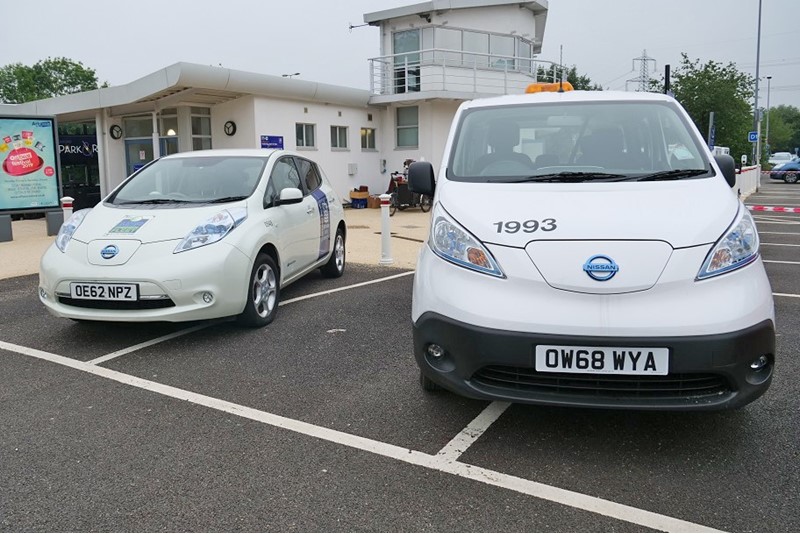London is often touted as the UK leader when it comes to addressing emissions from road transport. In 2008, it became the first city to introduce a low emission zone, targeting truck diesel emissions, then last year it became the first to set its sights at pre-Euro 6 diesel and pre-Euro 4 petrol vehicles of all types with the stricter ultra-low emission zone (ULEZ).
But the city, arguably, setting out the most ambitious plans to tackle the climate crisis is Oxford, which has outlined its blueprint for a zero-emission zone in the city centre by summer 2021.
While that’s a Covid-19-enforced delay from the original December 2020 launch date, it’s also the first phase of a two-stage plan that will cover the entire city centre by 2022.
Part one, dubbed the ‘red zone’, covers a small central area of the city and will charge all non-zero-emission vehicles £10 for entering between 7am and 7pm; part two, the ‘green zone’ will encompass the rest of the city and offer discounted charges for vehicles that comply with the London ULEZ.
But those are simply the headlines. Oxford City Council has a far-reaching strategy to improve air quality and reduce carbon which includes support for local businesses, investment in active travel and public transport, and an overhaul of its own fleet.
Tom Hayes, recently appointed deputy leader at the council, has been Oxford’s cabinet member for green transport and zero carbon since 2017. He’s also a transport policy board member at the Local Government Association and well versed in the need to address the climate agenda.
“When the city council declared a climate emergency in January 2019, we recognised we had to take unusual measures to tackle an unusual situation,” Hayes says.
The biggest challenge would be to “bring people along with us – we have to have zero-carbon citizens”.
Citizens’ assembly
Consequently, Oxford became the first UK city to hold a citizens’ assembly on climate change to gauge the views of residents and businesses. This looked at the main causes of carbon emissions in the city, of which transportation contributed 19%, and asked for their recommendations.
Active and sustainable transport topped the list, with widespread support for a zero-emission zone and segregated cycle lanes. But they also wanted Oxford City Council to lobby central Government for a change in the framework, including bringing forward the ban of petrol and diesel vehicles from 2040 to 2030.
The announcement of a zero-emission zone (ZEZ), first mooted by the council in 2017, has nurtured an environment for innovative suppliers to begin trialling sustainable transport solutions, while Oxford recognised its responsibilities lay in creating the infrastructure to facilitate behavioural change among business and the public.
“We’ve committed a £19 million budget to the zero-carbon agenda,” Hayes says. “But we’ve also seen investment come into the city.”
Among new sustainable transport businesses springing up in the city are Pedal and Post, which delivers mail, including medical supplies, to one of the universities, and Oxwash, a laundry cleaning service. Both use cargo bikes, e-bikes and push bikes to make their deliveries.
Meanwhile, Co-Wheels’ Oxford business has become one of the largest EV car clubs outside of London, tapping into an EV-savvy demographic.
Coronavirus, while having a terrible impact on lives and the global economy, has given the city council and the public a glimpse of an ecosystem where personal transport is far less essential.
“What we are looking at is a real-world experiment of what would happen if you took private cars off the road, seeing the benefits in terms of quieter streets, reduced air pollution and cleaner air to breathe, but also looking at the future of social distancing when we are on the street,” Hayes says.
“We are looking at widening the pavements in core parts of the city, giving roads over to buses so they have priority or to segregated cycle lanes. We’re looking at how we increase the number of bike journeys (push bikes and e-bikes) within the city, but we are also looking at how those new segregated cycle lanes connect into the villages and towns of the county.”
Tweaks and fine tuning
Much of this work will be a continuation of the Connecting Oxford policy, with some tweaks and fine-tuning to adapt to the Covid-19 pandemic. The policy includes a £300m proposal to develop a cycle greenways initiative serving the city and neighbouring districts, which saw the city council work closely with the county council, as it did on the ZEZ proposals.
Electric vehicle (EV) uptake by local business and the public is critical to the success of the zone, and fundamental to that is the charging infrastructure.
The £41m Energy Superhub Oxford (ESO) rapid charging project is a three-year joint initiative led by Oxford City Council and Pivot Power (an EDF Renewables company) which includes Habitat Energy, Invinity Energy Systems, Kensa Contracting and the University of Oxford.
Aided by £10m from the Government, ESO will install an 8km (five mile) private wire network around the south of Oxford connecting public charging facilities at Redbridge Park & Ride to the national grid.
It has capacity to expand with EV adoption and provide power for local businesses seeking to electrify their fleets.

The first stage will see installation of 20 charge points ranging from rapid (50kW+) to ultra-rapid (150kW+), capable of charging a car in 15-50 minutes, and 30 fast charge points (at least 7kW) which can charge a car over a period of hours.
ESO will have the world’s largest hybrid energy storage system, which will share the grid connection with the private wire network to facilitate mass-scale charging while minimising peak demand on the local grid.
The council is now looking into the number of charging points it might, ultimately, need in the city, and the best locations, to deliver wholesale migration to electric, and whether those facilities should always be clustered in hubs or focus more on individual charge points.

To gain the confidence and trust of the business community, Oxford recognised it needed to set an example by electrifying its own fleet. It has placed an order for 33 EVs – a mix of cars, vans, a street sweeper and an excavator – with funding unlocked via the ESO project. It will take the council to 40 EVs by the end of the year, almost halfway to its target of electrifying “at least 25%” of its 339-vehicle fleet by 2023.
“We are doing this not just because we want our own fleet to be completely right, but we recognise we can try to shift the market, showcasing to other councils what is possible,” Hayes says.
He’s excited about supplementary opportunities offered by electric, such as alternative hours for refuse collection vehicles (RCVs). As electric is silent, why not collect rubbish at 4am when the roads are quiet, rather than the traditional 8am, for example. “We could have a much smoother operation as a result,” Hayes adds.
Oxford has just started trials with a Dennis Eagle electric RCV; if it replaced all 27, it would save almost 750 tonnes of CO2 a year.
The ESO project will also fund a ‘try before you buy’ scheme for Oxford’s Hackney Carriage taxi drivers with Electric Blue, enabling drivers to trial one of two models – an all-electric Nissan Dynamo or an LEVC – for a two- or four-week period. From 2025, drivers will only be able to get a licence if they have a zero-emission capable cab.
Overall, ESO aims to save 10,000 tonnes of CO2 per year by 2021, rising to 25,000 tonnes by 2032.
Additional co-benefits
While Oxford is focused on achieving zero carbon, the strategy has a multitude of additional benefits which weren’t initially appreciated by the council and its advisory group.
Hayes went into the first citizens’ assembly, a representative cross-section of the local population, thinking he’d be discussing trade-offs on council priorities. What he hadn’t considered were the co-benefits.
“People were saying if you have fewer vehicles on the road, then you not only achieve a reduction in air pollution, but you improve public health,” he says. “You improve safety. You allow for more spaces to be taken over for trees which improves the scenery. You make it a more walkable city.
“So, now we focus on the co-benefits. And that’s a big learning for us and other councils.”
Business consultation key to ZEZ introduction
Oxford City Council took the decision to delay the introduction of the zero-emission zone ‘red zone’ from the end of 2020 to summer 2021 following an attempt to consult with businesses that coincided with the outset of the coronavirus pandemic.
“The businesses we needed to consult were clear that they were just trying to keep their businesses afloat and couldn’t contribute,” says Tom Hayes.
“So, to make sure we launched the zero-emission zone in a way that didn’t damage the local economy at a time when it is already on its knees, we delayed the zone until summer next year. That allows for the necessary consultation with business.”
Currently, proposals will ban all non-zero-emission vehicles from entering the red zone between 7am and 7pm, including vans and HGVs which are delivering goods and services to local businesses. The inevitable response from the trade associations was that it was unfair to penalise operators when there were no compliant models available in those vehicle segments.
Hayes is dismissive of such suggestions: “It’s a zero-emission zone within a 12-hour period – you can shift your deliveries outside of that. We’ve seen businesses make even bigger changes to respond to the pandemic.”
He adds: “The overwhelming thing that business wanted was certainty. If it’s going to cause us to incur extra cost, at least we know and can start planning for it.”
Communication with local companies has helped the council to gain their trust in delivering the red zone, taking their concerns into consideration. This will be even more important when the zone extends to the green zone in 2021/22.
The move will be “sensitive to business considerations, but not defined by them”, Hayes says. “We will reflect on the hours of operation, whether they are seven-to-seven, and the vehicles types that are best responding to the red zone. Its important to incorporate learning and not just rush in to have a clear air zone or zero emissions.”





















Login to comment
Comments
No comments have been made yet.